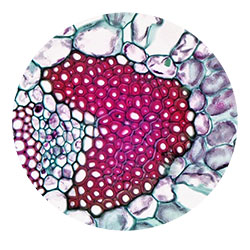
Campus Life Spotlight
Faye Reynolds
Bioscience Image Library Project
my Philosophy
Professor Faye Reynolds has created BCC's Bioscience Image Library – which offers the general public free access to microscopic images of plants, animals, bacteria, fungi and more. Free access to the image library can support student learning in the fields of Biology, Botany, Zoology, Histology and Microbiology.
Fayette (Faye) Reynolds, a biology professor here at the College, was on sabbatical and writing lab manuals for biology classes when she was noticing that she couldn’t find copyright free images to include with the manuals she was creating.
Faye heard from other bioscience faculty that while it is easy to share curriculum with one another, it’s nearly impossible to share their work because there weren’t any images to go along with their texts (unless, of course, you were willing to pay for the images). A text could be shared at great length, but there would be a disconnect between what was written and what was understood due to the lack of pictures to illustrate complex biological references.
So, Faye decided to begin the painstaking process of imaging microscopic details of various plant specimens using the College’s microbiology camera. Faye spent 50-60 hours a week taking photos and also wrote the annotated descriptions of what was imaged.
"I had to reteach myself botany in order to write up the descriptions of each image in biological terms” Faye said. “I haven’t taken botany since college, but I knew these images need the image annotations to be of use to educators who might use them."
The photo sharing website, Flickr, hosts the images found within the library. Faye was able to catalog 730 annotated images in the microscopic world of plants – including roots, stems, leaves, tissues and more. “I wanted to categorize the plant specimens in a way that is helpful to teachers and students in botany,” Faye said. “I’ve broken out the categories to match with all of the anatomical parts of a plant that are taught in college science classes.”
Faye realizes that these images have many applications outside of the scientific realm. They are amazing images that teachers could consider using in their art classes.
Faye wants this to be accessible, useful, and meaningful to people who are looking for free images of micro and macro biology. “I plan on finishing up the rest of the plant images – there is roughly three-four hundred hours left there,” Faye said. “You can’t just take one microscopic photo, you need to take about ten. Then, you need to clean it up in Photoshop and research and write the content.”
“I love it though,” Faye adds, “It’s a part of my job that I really enjoy.”
The plan is also to start cataloging images of animals next too, which should begin this spring. Faye invites people to send her images of big animals, and has been working with the environmental science faculty at the College to prepare macro photos of reptiles, amphibians, birds and mammals.
Faye notes that no one is doing this anywhere – offering free microscopic bioscience images and descriptions for use as an open educational resource (OER).
“This is just a philosophical viewpoint on education that I have – we should give a quality educational experience, including access to learning opportunities, without a lot of expense” Faye said. “Some things just need to be free.”
View and contribute to the free BCC Bioscience Image Library.
